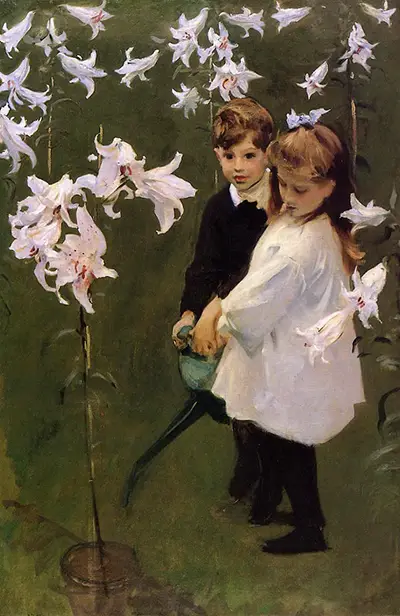 Buy Art Prints Now
Buy Art Prints Nowfrom Amazon
* As an Amazon Associate, and partner with Google Adsense and Ezoic, I earn from qualifying purchases.
Garden Study of the Vickers Children was painted by Italian-born American artist John Singer Sargent (1856–1925) in 1884
Of Sargent's known 900 oil paintings and 2000 watercolours, this oil on canvas portrait painting is considered one of his more notable works.
Despite his American nationality, Sargent's family had travelled around Europe and Sargent himself resided in numerous countries.
Considered the leading portrait artist of his generation, and celebrated in his own lifetime, he was particularly famed for his portraits of leading society figures in Paris, New York and London. Monet also produced many cityscape paintings in London himself, whilst studying the work of William Turner and John Constable in the national galleries.
Having moved to England from Paris following a scandalous exhibition of a risque painting of Madame X at the Paris Salon, Sargent started work on this painting in the summer of 1884, at the Vickers' home in Sussex, England. Painted seven years after his first major portrait painting, just before the height of his demand as a fashionable society portrait painter, the painting depicts two children watering flowers in a garden.
The children shown are Vincent and Dorothy, the children of Albert and Edith Vickers. Sargent was originally commissioned by Albert Vickers' brother Thomas to paint their own children. Thomas and his wife Frances had travelled all the way to Paris to identify a suitable artist for this task.
Sargent completed eleven known portrait paintings of the Vickers family and these ultimately became some of his best known works. Singer Sargent is known to have been inspired by the likes of Thomas Gainsborough and Diego Velazquez.
The painting exhibits a stark contrast between the dark background and the white flowers and the children's faces. One of the siblings is captured looking directly at the painter - it is to this face one's eye is immediately drawn. The large white lilies are as tall as the children themselves and positioned in plant pots. The vibrant stamens of the fully opened lilies and an additional element of colour as well as the children's hair. Some of the lilies are depicted as trumpets, yet to fully bloom.
A characteristic of Sargent's work is that he could make the subject appear both close and distant, resulting in a paradoxical sense of intimacy and intrigue. He was also renowned for his portrayal of animated facial expressions, imbuing the resulting work with the sitter's individual character and distinguishing him from previous portrait artists.
Sargent was also celebrated for his incredible sense of composition, refined technique and textural richness achieved using oils on fine plain weave canvases. Having studied The Old Masters, he combined formal composition with fervent and bright pseudo-Impressionist brushstrokes, painting in half tones.
By shifting the boundary between the subject and the background, he created an enigmatic balance of shape and colour. With large brushes and liberal use of turpentine and oil paint, Sargent believed that the more paint used, the more the colour flowed. Although today, these portrait paintings seem quite traditional, at the time of creation they were considered quite theatrical and extremely modern.
This painting is an example of the art movement 'realism', wherein in the artist endeavours to represent everyday subject matter as accurately as possible. Sitting for a Sargent painting required confidence and daring as he was not an artist to paint his subjects in a more flattering light. As he was quoted as saying: "I do not judge, I only chronicle. Every time I paint a portrait I lose a friend.
I don't dig beneath the surface for things that don't appear before my own eyes." Indeed, Sargent’s style was considered 'perfect empathy'. However, French Impressionist painter Camille Pissarro (1830–1903) claimed he was a “Gilded Age flatterer” (the Gilded Age ran from ~1870–1890) and American visual pop artist Andy Warhol commented that Sargent “made everybody look glamorous. Taller. Thinner. But they all have mood, every one of them has a different mood." One of his biographers, Evan Charteris, described his portraits as revealing “the sitter’s inner nature against fashion’s constantly shifting ideals.”
Sargent would step back after each brushstroke, wearing tracks in the carpet while doing so. It is thought that he could cover up to 4 miles a day pacing around. He was also known for talking constantly while he painted, as well as taking breaks to play the piano.
Sargent was friends with several other artists including French sculptor Auguste Rodin (1840–1917), French impressionist painter Claude Monet (1840–1926), French portrait artist Paul César Helleu (1859–1927) and American-Austrian sculptor and painter Emil Fuchs (1866–1929).
He is also known to have been on a strong influence on other artists such as African-American visual artist Archibald Motley (1891–1981), American visual pop artist Andy Warhol (1928–1987) and UK portrait artist Isabella Watling (1990–). Measuring 138 x 91 cm, 'Garden Study of the Vickers Children' is currently located at the Flint Institute of Arts, Flint, Michigan, USA.




